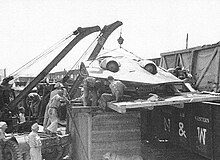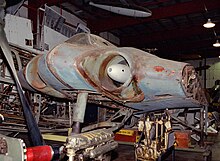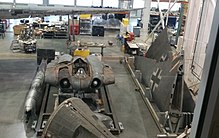Hoarding H IX
| Hoarding H IX | |
|---|---|
 Three-sided projection of the H IX V1 |
|
| Type: | Fighter plane |
| Design country: | |
| Manufacturer: |
Brothers Horten |
| First flight: |
March 1, 1944 (Horten H IX V1) |
| Commissioning: |
- |
| Production time: |
only reached prototype stage |
| Number of pieces: |
3 well-known prototypes |
The end of the Second World War built flying wing -construction Horten H IX was the logical continuation of the Nurflügelkonzeptes brothers Horten into the jet age . H IX was the name of the first two prototypes. The Reich Aviation Ministry (RLM) assigned the number 8-229 for series production, with 8 being a code number for aircraft in general.
Sometimes the name Gotha Go 229 - after the intended production company Gothaer Waggonfabrik - is used. In practice, however, the production company was generally irrelevant for the naming. Since the Horten brothers were not employees of the Gothaer Waggonfabrik and also officially had their own aircraft company - albeit without significant production capacities - the naming Horten Ho 229 is more likely. This designation was also used in the weekly reports of the Rechlin test center.
history
development
To this day it is not entirely clear how the Horten brothers were able to continue their developments within the structure of the Third Reich. Walter Horten was on the staff of General Adolf Galland . As such, he was aware of most of the developments in this area. Through his collaboration with Wolfgang Späte , he knew that the Messerschmitt Me 163 would probably not be able to meet the expectations placed on it. The H IX was designed as a twin-engine fighter as an alternative to the Me 262. The development took place "semi-officially" with the support of some offices in the RLM, but without a major official order. The development took place without much government support within the "Sonderkommando IX" created especially for this purpose in a motorway maintenance depot near Göttingen . The construction work was done almost exclusively by Reimar Horten , as his brother was indispensable in Berlin.
The first prototype H IX V1 was a non-motorized glider that Heinz Scheidhauer first flown on March 1, 1944. Scheidhauer had a lot of experience with the flying wing constructions of Horten and certified that the aircraft had very good flight behavior. The glider had a non-retractable three-legged landing gear, with the main landing gear legs being provided with aerodynamic fairings.
On September 21, 1944 the hoarding project was belatedly included in the so-called hunter emergency program. The second prototype should be equipped with jet engines. The plan was first the BMW 003 - engines . However, since the development at BMW did not progress to the desired extent, Junkers Jumo 004 engines had to be used. This engine, however, was mainly larger in diameter than the unit from BMW; therefore the wing center section had to be laboriously converted. Due to the thickening of the wing center part, the calculated maximum speed decreased. The result, however, was a jet aircraft that still seems futuristic today, which probably made a short unplanned flight with Erwin Ziller on December 18, 1944 in Oranienburg and then made its official maiden flight on February 2, 1945. The aircraft was also certified as having good flight characteristics. Ziller had previously made a few takeoffs with the Me 262 in order to familiarize himself with the handling of the jet engines.
During the third - or fourth with the test flight on December 18, 1944 - an accident occurred on February 18, 1945 after about 45 minutes of flight time during the approach. It was probably triggered by the failure of the right engine, which at the same time drove the hydraulic pump and had already caused problems before take-off. Erwin Ziller previously tried to get the engine going again in a wave flight and already extended the landing gear at a height of 400 meters with the help of the compressed air reserve . But he could no longer get the plane under control and crashed the plane in front of a railway embankment. Upon impact, he was thrown out of the plane into a tree in the garden of a gatekeeper's house and died of a broken neck . The arriving observers saw the engines that had been thrown forward from the fuselage lying on the railway embankment, the left engine still running out and warm, while the right engine was already cold. Nevertheless, the RLM placed a production order for 40 aircraft with Gothaer Waggonfabrik .
None of the Horten brothers was present during the motorized flight tests. The front was relatively close to the Oranienburg airfield , where the tests took place. The "Sonderkommando IX" was soon disbanded, and Reimar Horten was already working on the Horten H XVIII , a six-engined long-range flying wing bomber with which attacks on the United States were to be flown. The realization of such a project was completely illusory at the time. In the V3 obtained, the air inlets were moved in front of the leading edge of the wing and had circular inlet lips.
Handover of the project to the Gothaer Waggonfabrik
While the "Sonderkommando IX" was dissolved, further prototypes were already under construction in Friedrichroda under the management of the Gothaer Waggonfabrik. The designers at Gothaer Waggonfabrik made some design changes, in particular some simplifications with regard to the planned series production. Initially, V3 to V5 were commissioned. Series production was planned with BMW 003 engines, but due to a lack of availability, V3 to V5 still had to be equipped with Jumo 004 engines, although the Rechlin test center described this as "not responsible for maintenance and flight safety". A modified middle section was planned for the Gothaer Waggonfabrik, which should have a wider driver's seat and a larger distance between the engines. Due to the greater distance between the engines, however, the ammunition boxes would have had to be relocated from the middle section to the outer wing, which would have resulted in the loss of fuel capacity and thus range. V6 to V8 were planned as reconnaissance aircraft with this modified hull. At the end of March 1945, the "Technical Air Armament" did not want to commit to any specific purpose due to a lack of sufficient testing. But ten more test models V6 to V15 were ordered. Meanwhile , a dummy in the design of the planned V6 was built in Ilmenau . It was intended to serve as a sample for series production and was therefore continuously updated with the changes made during construction.
On April 14, 1945, US troops reached the production facility in Friedrichroda and captured the almost completed V3 as well as construction documents.
The conflict between hoarding and Gotha
The H IX was initially intended to be used primarily as a fighter aircraft. Göring had already planned to use the 1./JG 400 at Brandis airfield - at the time, Me-163 rocket planes were stationed there. At the Gothaer Waggonfabrik there were doubts about the suitability of this aircraft as a fighter aircraft; it was seen more in the role of a bomber, as it was assumed that the hoarding could not target enemy bombers precisely enough due to the lack of conventional tail units. Instead of a conventional vertical stabilizer, the Horten brothers used air brakes near the wing tips. Gotha also tried an alternative with the Gotha P.60 .
The further development at Horten and Gotha was largely independent of each other, which in retrospect leads to confusion. The V6 planned by Gotha (as mentioned above) should receive a widened cockpit and V6 to V8 should be equipped as reconnaissance aircraft. The Horten brothers, apparently in ignorance of the plans at Gotha, developed a two-seater variant called the H IXb , which was also called the V6, and a two-seater night fighter called the V7. Attempts at this construction were made with one of the remaining H II .
construction
The wing center section essentially consisted of a tubular steel frame covered with plywood ; the wings were made entirely of plywood. Reimar Horten originally planned a fuel-resistant gluing and impregnation in order to be able to use the cavities as a tank and thus to maximize the fuel volume. There were divided flaps on the central wing and elevons on the outer wing . Extendable two-part spoilers near the wing tips functioned (operated on one side) as rudders . At high speeds only the smaller brake flaps should be used for control, at low speeds or if one engine fails, both flaps were used coupled. Due to the thickening of the central wing, which was necessary as a result of the engine change, the calculated maximum speed fell below 1000 km / h. The aircraft was originally intended to be equipped with a spring-operated ejection seat . However, since it was judged to be inadequate by the Rechlin test center , a catapult seat operated with an explosive cartridge was to be used. Since there was no pressurized cabin , the Dräger company developed a first pressurized suit for pilots for flights at high altitudes , which with its helmet looked like a forerunner of today's spacesuits , but in the intended design proved to be impractical. As far as possible, the landing gear components were taken over from aircraft that were produced in the Luftwaffe's dismantling facilities ( Bf 109 / Me 210 / He 177 ).
The original approach of doing without the hull was patented by Hugo Junkers as early as 1910 . Here only the wings provided the necessary lift in the air, while the fuselage and the rudder were to a certain extent "ballast". If it were possible to reduce these parts and build an aircraft that consisted only of the wings, it would have to have superior flight characteristics. In practice, Junkers considerations could not be implemented. An aircraft could hardly be controlled without the tail unit and fuselage, which would lead to a crash if the wings were stalled.
Whereabouts
After the investigation by the Americans, the V1 was left behind badly damaged and finally burned.
An H IX arrived in the UK to be examined at Farnborough . It is not clear which machine it was. Since Eric Brown , who examined numerous captured German aircraft for Great Britain, stated that the machine looked as if it had crashed, it was probably the remains of the V2 from Oranienburg.
The almost completed hull of the V3 was captured by the Americans in Friedrichroda . The wings, which were also still unfinished, were confiscated in Sonneberg and presumably completed in the USA. It was originally planned to undertake test flights at Freeman Field. However, they did not materialize, particularly because of concerns about the unreliable Jumo 004 engines. The V3 was painted after the war in the USA to show it on booty shows. It then went to the Paul E. Garber Facility of the National Air and Space Museum . Since 2014 it has been restored in the Restoration Hangar of the Steven F. Udvar-Hazy Center and can be viewed from the visitors' gallery.
V4 was estimated by the Americans to be two-thirds completed. The engines were already built into the tubular frame of the V4. V5 had only just begun, only the pipe framework was in place. The whereabouts of V4 and V5 is unclear. The dummy of the V6 was already destroyed when the Americans arrived in Ilmenau . Only some of the control surfaces of the V6 were still intact.
Technical specifications
| Parameter | Hoarding IX V3 |
|---|---|
| crew | 1 |
| length | 7.47 m |
| span | 16.8 m |
| height | 2.81 m |
| Wing area | 50.20 m² |
| Empty mass | 4,600 kg |
| payload | 1,000 kg |
| Max. Takeoff mass | 8,100 kg |
| Top speed | 977 (1,000) km / h * |
| Rate of climb | 1,320 m / min * |
| Service ceiling | 15,000 m * |
| Range | 1,900 km * |
| Engines | 2 × Jumo-004-B2 jet engines, each 8.7 kN thrust |
| Armament | 4 × MK 108 (planned) |
* Planned or calculated data (the Ho 229 V3, in contrast to the H IX V2, never flew)
Stealth Properties and Other Myths
In the 40 years after the end of the war, the H IX received little attention in the specialist press and was almost never mentioned. It was only with the appearance of the autobiography of Reimar Horten and the appearance of the B2 bomber that a real hype developed around the machine, especially when it became known that the H IX V3 still existed and was stored in Silver Hill. It is just as unlikely to be titled “Hitler's stealth bomber”. Although Göring or the RLM took up every absurd idea towards the end of the war in order to master the Allied air superiority, there is no evidence that Adolf Hitler had any knowledge of the existence of the Ho 229.
Reimar Horten claimed in his book that he and his brother Walter had taken targeted measures to camouflage the H IX radar. For example, adding coal dust to the glue should serve this purpose. According to Karl Nickel , who, among other things, carried out aerodynamic calculations for the Horten brothers, this mixture served "only as a filler" - the coal dust only served to save weight. On the other hand, it had long been known that the wooden de Havilland DH98 Mosquito was more difficult to detect by the radar devices of the time than comparable metal aircraft. During the testing of the much larger Northrop XB-35 , it later turned out that the aircraft disappeared from the radar screen under certain conditions thanks to the small reflective surface.
The claims of Reimar Horten and an optical resemblance to the stealth bomber Northrop B-2 led to the myth that the Ho 229 was the first stealth aircraft . However, there are no references to special radar camouflage techniques in surviving contemporary documents. The occasional claim that coal dust was found in the paintwork does not apply to the Ho 229 V3: it was unpainted when it was captured, and this was also the case when it arrived in the United States. So the paint was only applied there. In addition, due to the large nose landing gear, the entire design of the H IX was not designed for the installation of a bomb aiming device, which also contradicts the myth of "Hitler's stealth bomber". In contrast, the heavy cannon armament indicates the primary purpose as a hunter.
According to some sources, there should also have been a comparison flight with a Messerschmitt Me 262 . The aim is due to the lower the H IX surface load a better curve and climbing behavior have shown. The small number of test flights completed and the lack of documents about this event give rise to doubts as to whether this comparison flight actually took place at such an early stage of the flight test. It is more likely that Ziller, who had been instructed in the handling of the Jumo engines on an Me 262, compared the flight characteristics of both aircraft and reported on them.

The Northrop B-2 is often depicted as a direct offshoot of the H IX - but this cannot be proven. The B-2 is a late successor to the post-war Northrop XB-35 and YB-49 designs .
In early 2009, Northrop produced a non-airworthy 1: 1 model of the Ho 229 V3 as part of a documentation for the National Geographic Channel . With the dummy made of wood and plastic, whose tubular steel frame, tanks, engines and other equipment were simulated by supposedly equally reflective special silver paint, tests were carried out with regard to radar reflection.
Compared to the conventional bombers that were used in the Battle of Britain in the 1940s, the detection range for the Chain Home radar systems was reduced by around 20% . In connection with the higher flight speed, the advance warning time would have been reduced from 19 minutes to a maximum of 8 minutes, at an approach altitude of around 15 meters above sea it would probably have been only 2.5 minutes. According to the National Geographic report, high-frequency tests on the original cell showed that the aircraft skin had a radar-absorbing effect.
literature
- Reimar Horten, Peter F. Selinger: Nurflügel. The history of the Horten aircraft 1933–1960. Weishaupt, Graz 1993, ISBN 3-900310-09-2 .
- David Myhra: The Horten Ho 9 / Ho 229 Retrospective. Schiffer Publishing, September 2002, ISBN 0-7643-1666-4 .
- David Myhra: The Horten Ho 9 / Ho 229 Technical History. Schiffer Publishing, September 2002, ISBN 0-7643-1667-2 .
- Huib Ottens, Andrei Shepelev: Horten Ho 229 Spirit of Thuringia. Classic Publications September 29, 2006, ISBN 1-903223-66-0 .
Web links
- Horten Ho IX wonder weapon "Wonder Weapon". (Video stream 8:27 min) In: History. ZDF , accessed on August 1, 2011 .
- Report on one day
- Plans, National Geographic
- Documentary about secret projects in the Third Reich (including with the flying wing)
Individual evidence
- ↑ mdr.de: Text for the television documentary "The invisible flier" ( Memento from October 14, 2013 in the Internet Archive )
- ↑ The Horten Ho 229 was the Nazis' most mysterious aircraft. March 24, 2020, accessed March 27, 2020 .
- ↑ Smithsonian National Air and Space Museum http://airandspace.si.edu/collections/artifact.cfm?object=nasm_A19600324000
- ↑ Russ Lee: Horten Ho 229 V3. National Air and Space Museum , September 2, 2004; accessed January 9, 2011 .
- ^ TV documentary, National Geographic Channel , p. Minutes 12-14 of 15; English.
- ↑ Television documentary, National History Channel ( Memento of December 9, 2012 in the Internet Archive ), replica of the Horten IX from Northrop and test of the stealth properties.







